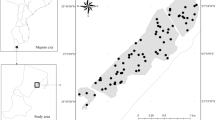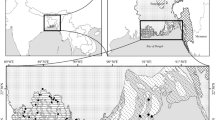Abstract
Estuarine ecosystems are changing rapidly in response to anthropogenic impacts. Mangrove expansion in New Zealand is mainly attributed to favourable climatic conditions and increased sedimentation due to land use change. This expansion is associated with large scale shifts in ecosystem structure and function, with significant potential impacts on coastal carbon and nitrogen storage. A fundamental aspect of understanding these impacts is accurately estimating storage within above ground biomass. We developed allometric equations to estimate above ground biomass, carbon and nitrogen stocks for temperate Avicennia marina subsp. Australasica growing near the southern limit of the species distribution range in New Zealand. We compare these equations with existing equations for Avicennia spp. Tree height, trunk circumference, tree canopy volume and tree canopy area were strong predictors of total above ground biomass, carbon, and nitrogen stocks. Carbon and nitrogen stocks accounted for 41.23 ± 0.40 % and 1.28 ± 0.03 %, respectively, of total above ground biomass. This study is the first to develop allometric equations to estimate biomass, carbon and nitrogen stocks in temperate Avicennia marina. These equations can be used to improve assessments of the impact of changes on mangrove forest structure and function, in particular carbon and nitrogen storage.

Similar content being viewed by others
References
Aerts R, Chapin FI (2000) The mineral nutrition of wild plants revisited. Adv Ecol Res 30:1–67
Alfaro AC (2006) Benthic macro-invertebrate community composition within a mangrove/seagrass estuary in northern New Zealand. Estuar, Coast Shelf Science 66(1–2):97–110. doi:10.1016/j.ecss.2005.07.024
Alongi D, Clough B, Dixon P, Tirendi F (2003) Nutrient partitioning and storage in arid-zone forests of the mangroves Rhizophora stylosa and Avicennia marina. Trees 17(1):51–60. doi:10.1007/s00468-002-0206-2
Alongi DM (2013) Cycling and global fluxes of nitrogen in mangroves. Glob Environ Res 17:173–182
Balke T, Swales A, Lovelock CE, Herman PMJ, Bouma TJ (2015) Limits to seaward expansion of mangroves: Translating physical disturbance mechanisms into seedling survival gradients. J Exp Mar Biol Ecol 467:16–25. doi:10.1016/j.jembe.2015.02.015
Barbier EB, Hacker SD, Kennedy C, Koch EW, Stier AC, Silliman BR (2010) The value of estuarine and coastal ecosystem services. Ecol Monogr 81(2):169–193. doi:10.1890/10-1510.1
Beard, C.M. (2006). Physiological Constraints on the Latitudinal Distribution of the Mangrove Avicennia marina (Forsk.) Vierh. subsp. australasica (Walp.) J. Everett (Avicenniaceae) in New Zealand. PhD Thesis., University of Waikato, Hamilton, New Zealand
Beauchamp JJ, Olson JS (1973) Corrections for bias in regression estimates after logarithmic transformation. Ecology 54(6):1403–1407. doi:10.2307/1934208
Bouillon S, Borges AV, Castañeda-Moya E, Diele K, Dittmar T, Duke NC, et al. (2008) Mangrove production and carbon sinks: a revision of global budget estimates. Glob Biogeochem Cycles 22(2). doi:10.1029/2007GB003052
Briggs SV (1977) Estimates of biomass in a temperate mangrove community. Aust J Ecol 2(3):369–373. doi:10.1111/j.1442-9993.1977.tb01151.x
Bulmer RH, Lundquist CJ, Schwendenmann L (2015) Sediment properties and CO2 efflux from intact and cleared temperate mangrove forests. Biogeosciences 12(20):6169–6180. doi:10.5194/bg-12-6169-2015
Cai W, Borlace S, Lengaigne M, van Rensch P, Collins M, Vecchi G, et al. (2014) Increasing frequency of extreme el Nino events due to greenhouse warming. Nat Clim Chang 4(2):111–116. doi:10.1038/nclimate2100
CliFlo (2013). The National Climate Database. http://cliflo.niwa.co.nz/. Date accessed: 17/01/15
Comley BWT, McGuinness KA (2005) Above- and below-ground biomass, and allometry, of four common northern Australian mangroves. Aust J Bot 53(5):431–436. doi:10.1071/BT04162
Doughty C, Langley JA, Walker W, Feller I, Schaub R, Chapman S (2015) Mangrove range expansion rapidly increases coastal wetland carbon storage. Estuar Coasts 39(2):385–396. doi:10.1007/s12237-015-9993-8
Duke N, Ball M, Ellison J (1998) Factors influencing biodiversity and distributional gradients in mangroves. Glob Ecol Biogeogr Lett 7(1):27–47. doi:10.1111/j.1466-8238.1998.00269.x
Ellis J, Nicholls P, Craggs R, Hofstra D, Hewitt J (2004) Effects of terrigenous sedimentation on mangrove physiology and associated macrobenthic communities. Mar Ecol Prog Ser 270:71–82. doi:10.3354/meps270071
Enright NJ (2001) Nutrient accessions in a mixed conifer–angiosperm forest in northern New Zealand. Austral Ecolo 26(6):618–629. doi:10.1046/j.1442-9993.2001.01128.x
Hume TM, Herdendorf CE (1988) A geomorphic classification of estuaries and its application to coastal resource management—A New Zealand example. Ocean Shoreline Manage 11(3):249–274. doi:10.1016/0951-8312(88)90022-7
IPCC (2014). 2013 supplement to the 2006 IPCC guidelines for national greenhouse gas inventories. Intergovernmental Panel on Climate Change (IPCC). Switzerland.
Kelleway JJ, Saintilan N, Macreadie PI, Ralph PJ (2016a) Sedimentary factors are key predictors of carbon storage in SE Australian saltmarshes. Ecosystems:1–16. doi:10.1007/s10021-016-9972-3
Kelleway JJ, Saintilan N, Macreadie PI, Skilbeck CG, Zawadzki A, Ralph PJ (2016b) Seventy years of continuous encroachment substantially increases ‘blue carbon’ capacity as mangroves replace intertidal salt marshes. Glob Chang Biol 22(3):1097–1109. doi:10.1111/gcb.13158
Khan AB (2013) Assessment of carbon storage in Pondicherry mangroves, Pondicherry, India. Acta Biologica Malaysiana 2(3):95–99
Komiyama A, Ong JE, Poungparn S (2008) Allometry, biomass, and productivity of mangrove forests: a review. Aquat Bot 89(2):128–137. doi:10.1016/j.aquabot.2007.12.006
Konôpka B, Pajtík J, Moravčík M, Lukac M (2010) Biomass partitioning and growth efficiency in four naturally regenerated forest tree species. Basic Appl Ecol 11(3):234–243. doi:10.1016/j.baae.2010.02.004
Krauss KW, McKee KL, Hester MW (2014) Water use characteristics of black mangrove (Avicennia germinans) communities along an ecotone with marsh at a northern geographical limit. Ecohydrology 7(2):354–365. doi:10.1002/eco.1353
Lamlom SH, Savidge RA (2003) A reassessment of carbon content in wood: variation within and between 41 north American species. Biomass Bioenergy 25(4):381–388. doi:10.1016/S0961-9534(03)00033-3
LINZ (2016). LINZ (Land Information New Zealand Tide predictions). [Online]. Available: http://www.linz.govt.nz/hydro/tidal-info/tide-tables. Accessed 17/01/16 2016
Lovelock C, Feller I, Ellis J, Schwarz A, Hancock N, Nichols P, et al. (2007a) Mangrove growth in New Zealand estuaries: the role of nutrient enrichment at sites with contrasting rates of sedimentation. Oecologia 153(3):633–641. doi:10.1007/s00442-007-0750-y
Lovelock CE (2008) Soil respiration and belowground carbon allocation in mangrove forests. Ecosystems 11(2):342–354. doi:10.1007/s10021-008-9125-4
Lovelock CE, Ball MC, Choat B, Engelbrecht BMJ, Holbrook NM, Feller IC (2006) Linking physiological processes with mangrove forest structure: phosphorus deficiency limits canopy development, hydraulic conductivity and photosynthetic carbon gain in dwarf Rhizophora mangle. Plant Cell Environ 29(5):793–802. doi:10.1111/j.1365-3040.2005.01446.x
Lovelock CE, Feller IC, Ball MC, Ellis J, Sorrell B (2007b) Testing the growth rate vs. geochemical hypothesis for latitudinal variation in plant nutrients. Ecol Lett 10(12):1154–1163. doi:10.1111/j.1461-0248.2007.01112.x
Lovelock CE, Sorrell BK, Hancock N, Hua Q, Swales A (2010) Mangrove forest and soil development on a rapidly accreting shore in New Zealand. Ecosystems 13(3):437–451. doi:10.1007/s10021-010-9329-2
Macinnis-Ng C, Schwendenmann L (2015) Litterfall, carbon and nitrogen cycling in a southern hemisphere conifer forest dominated by kauri (Agathis australis) during drought. Plant Ecol 216(2):247–262. doi:10.1007/s11258-014-0432-x
Mackey A (1993) Biomass of the mangrove Avicennia marina near Brisbane, South-Eastern Queensland. Mar Freshw Res 44(5):721–725. doi:10.1071/MF9930721
Maniatis D, Saint André L, Temmerman M, Malhi Y, Beeckman H (2011) The potential of using xylarium wood samples for wood density calculations: a comparison of approaches for volume measurement. iForest. Biogeosci For 4(4):150–159. doi:10.3832/ifor0575-004
May JD (1999) Spatial variation in litter production by the mangrove Avicennia marina Var. Australasica in Rangaunu harbour, northland, New Zealand. N Z J Mar Freshw Res 33(2):163–172. doi:10.1080/00288330.1999.9516866
McLeod E, Chmura GL, Bouillon S, Salm R, Björk M, Duarte CM, et al. (2011) A blueprint for blue carbon: toward an improved understanding of the role of vegetated coastal habitats in sequestering CO2. Front Ecol Environ 9(10):552–560. doi:10.1890/110004
Morrisey DJ, Skilleter GA, Ellis JI, Burns BR, Kemp CE, Burt K (2003) Differences in benthic fauna and sediment among mangrove (Avicennia marina var. australasica) stands of different ages in New Zealand. Estuar Coast Shelf Sci 56(3–4):581–592. doi:10.1016/s0272-7714(02)00208-1
Morrisey, D.J., Swales, A., Dittmann, S., Morrison, M., Lovelock, C., and Beard, C. (2010). The ecology and management of temperate mangroves, in Oceonogr Mar Biolo. CRC Press 48:43-160
Nipithwittaya S, Bualert S (2012) Above ground carbon sequestration in mangrove forest filtration system. J Appl Sci 12:1537–1546
Osland MJ, Day RH, Larriviere JC, From AS (2014) Aboveground allometric models for freeze-affected black mangroves (Avicennia germinans): equations for a climate sensitive mangrove-marsh ecotone. PLoS One 9(6):e99604. doi:10.1371/journal.pone.0099604
Osland MJ, Enwright N, Day RH, Doyle TW (2013) Winter climate change and coastal wetland foundation species: salt marshes vs. mangrove forests in the southeastern United States. Glob Chang Biol 19(5):1482–1494. doi:10.1111/gcb.12126
Osland MJ, Enwright NM, Day RH, Gabler CA, Stagg CL, Grace JB (2016) Beyond just sea-level rise: considering macroclimatic drivers within coastal wetland vulnerability assessments to climate change. Glob Chang Biol 22(1):1–11. doi:10.1111/gcb.13084
Peichl M, Arain MA (2007) Allometry and partitioning of above- and belowground tree biomass in an age-sequence of white pine forests. For Ecol Manag 253(1–3):68–80. doi:10.1016/j.foreco.2007.07.003
Rodrigues DP, Hamacher C, Estrada GCD, Soares MLG (2015) Variability of carbon content in mangrove species: Effect of species, compartments and tidal frequency. Aquat Bot 120(Part B):346–351. doi:10.1016/j.aquabot.2014.10.004
Ross M, Ruiz P, Telesnicki G, Meeder J (2001) Estimating above-ground biomass and production in mangrove communities of Biscayne National Park, Florida (U.S.a.). Wetl Ecol Manag 9(1):27–37. doi:10.1023/a:1008411103288
Saenger P (2002) Mangrove ecology, silviculture and conservation. Springer, Berlin
Saintilan N (1997a) Above- and below-ground biomass of mangroves in a sub-tropical estuary. Mar Freshw Res 48(7):601–604. doi:10.1071/MF97009
Saintilan N (1997b) Above- and below-ground biomasses of two species of mangrove on the Hawkesbury River estuary, new South Wales. Mar Freshw Res 48(2):147–152. doi:10.1071/MF96079
Saintilan N, Wilson NC, Rogers K, Rajkaran A, Krauss KW (2014) Mangrove expansion and salt marsh decline at mangrove poleward limits. Glob Chang Biol 20(1):147–157. doi:10.1111/gcb.12341
Santini NS, Schmitz N, Lovelock CE (2012) Variation in wood density and anatomy in a widespread mangrove species. Trees 26(5):1555–1563. doi:10.1007/s00468-012-0729-0
Schwendenmann L, Mitchell ND (2014) Carbon accumulation by native trees and soils in an urban park, Auckland. N Z J Ecol 38(2):213–220
Sprugel DG (1983) Correcting for bias in log-transformed allometric equations. Ecology 64(1):209–210. doi:10.2307/1937343
Stokes, D.J. (2010). The physical and ecological impacts of mangrove expansion and mangrove removal: Tauranga Harbour, New Zealand. PhD Thesis. University of Waikato
Tam N, Wong Y, Lan C, Chen G (1995) Community structure and standing crop biomass of a mangrove forest in Futian nature reserve, Shenzhen, China. Hydrobiologia 295(1–3):193–201
Thakur, B. (2012). Mangrove nutrition along environmental gradients, firth of Thames. Unpublished MSc thesis. University of Auckland
Thrush SF, Hewitt JE, Cummings VJ, Ellis JI, Hatton C, Lohrer A, et al. (2004) Muddy waters: elevating sediment input to coastal and estuarine habitats. Front Ecol Environ 2(6):299–306. doi:10.2307/3868405
Woodroffe CD (1985) Studies of a mangrove basin, tuff crater, New Zealand: I. Mangrove biomass and production of detritus. Estuar Coast Shelf Sci 20(3):265–280. doi:10.1016/0272-7714(85)90042-3
Yando ES, Osland MJ, Willis JM, Day RH, Krauss KW, Hester MW (2016) Salt marsh-mangrove ecotones: using structural gradients to investigate the effects of woody plant encroachment on plant–soil interactions and ecosystem carbon pools. J Ecol 104(4):1020–1031. doi:10.1111/1365-2745.12571
Zhang Q, Wang C, Wang X, Quan X (2009) Carbon concentration variability of 10 Chinese temperate tree species. For Ecol Manag 258(5):722–727. doi:10.1016/j.foreco.2009.05.009
Acknowledgments
We thank the University of Auckland staff and students for field and laboratory assistance. We would also like to acknowledge NIWA Freshwater and Estuaries Centre core funding for this project (project #FWEH1402 and FWEH1502, “Mangrove ecosystem services”).
Author information
Authors and Affiliations
Corresponding author
Additional information
An erratum to this article is available at http://dx.doi.org/10.1007/s13157-017-0893-5.
Electronic supplementary material
Supplementary Table 1
Tree characteristics of each sampled tree used to develop the allometric equations for Avicennia marina subsp. Australasica. nd = no data, W = Whangamata, T = Tairua. (DOCX 28 kb)
Supplementary Table 2
Allometric equations for temperate Avicennia marina subsp. Australasica for different tree biomass components and carbon and nitrogen stocks (DOCX 39 kb)
Supplementary Figure 1
Images of single stem mangroves (Avicennia marina) in New Zealand, near their southern range limit. Clockwise from bottom left, example individual from 0.5–1 m size class, 1–1.5 m size class, 1.5–2.5 m size class, and >2.5 m size class. (JPEG 3912 kb)
Supplementary Figure 2
Map of Northern New Zealand showing location of study sites. Dashed lines indicate the southern boundary of Avicennia marina distribution in New Zealand. (JPEG 471 kb)
Rights and permissions
About this article
Cite this article
Bulmer, R.H., Schwendenmann, L. & Lundquist, C.J. Allometric Models for Estimating Aboveground Biomass, Carbon and Nitrogen Stocks in Temperate Avicennia marina Forests. Wetlands 36, 841–848 (2016). https://doi.org/10.1007/s13157-016-0793-0
Received:
Accepted:
Published:
Issue Date:
DOI: https://doi.org/10.1007/s13157-016-0793-0




